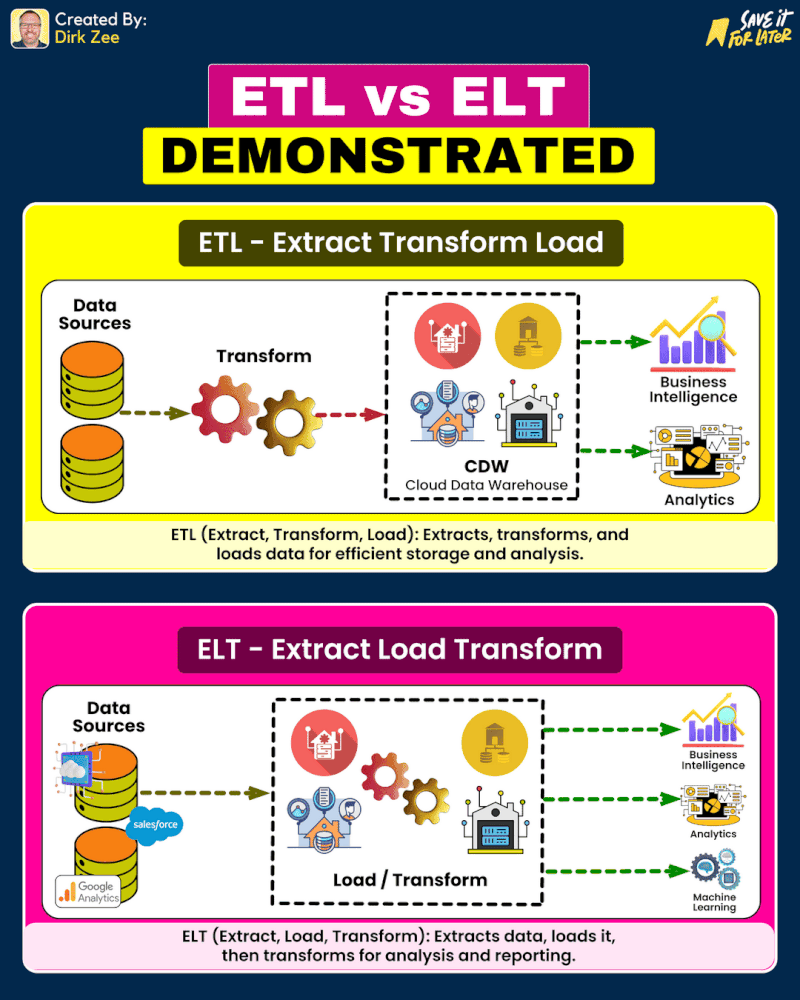So sánh ETL và ELT
Quote from bsdinsight on 25 November 2023, 00:00ETL/ELT are essential in the AI ecosystem, primarily for their role in data preparation and management.
1. Data Gourmet: They’re like master chefs, prepping vast amounts of clean, structured data to feed AI and ML models for accurate predictions.
2. Quality Enhancers: Both methods are pivotal in purifying data – think of them as filters improving the essence of data, crucial for AI’s performance.
3. Big Data Champions: ELT excels with big data, leveraging powerful cloud warehouses to efficiently train robust AI models.
4. Real-Time Reactors: In scenarios like fraud detection, ELT’s speedy data handling enables AI to respond instantly.
5. Data Lake Explorers: ELT is key in filling data lakes with raw data, offering a treasure trove for AI’s flexible exploration and innovation.
6. AI Enhances ETL/ELT: It’s a two-way street; AI and ML also refine ETL/ELT processes, automating and streamlining tasks like data cleaning and integration.
They help in ensuring that the data fed into AI models is of high quality and is processed efficiently, which is critical for the success of any AI initiative.
𝐄𝐱𝐩𝐥𝐨𝐫𝐢𝐧𝐠 𝐭𝐡𝐞 𝐃𝐚𝐭𝐚 𝐋𝐚𝐧𝐝𝐬𝐜𝐚𝐩𝐞: 𝐄𝐓𝐋 𝐯𝐬. 𝐄𝐋𝐓
𝐄𝐓𝐋 (𝐄𝐱𝐭𝐫𝐚𝐜𝐭, 𝐓𝐫𝐚𝐧𝐬𝐟𝐨𝐫𝐦, 𝐋𝐨𝐚𝐝):
– 𝐄𝐱𝐭𝐫𝐚𝐜𝐭𝐢𝐨𝐧: Gather data from source systems, often structured and batch-oriented.
– 𝐓𝐫𝐚𝐧𝐬𝐟𝐨𝐫𝐦𝐚𝐭𝐢𝐨𝐧: Process and modify data in a staging area to meet target database requirements.
– 𝐋𝐨𝐚𝐝𝐢𝐧𝐠: Transfer transformed data to the destination data warehouse or database for analysis.
– 𝐒𝐞𝐪𝐮𝐞𝐧𝐭𝐢𝐚𝐥 𝐅𝐥𝐨𝐰: Follows a linear process, suitable for batch-oriented data integration tasks.
– 𝐃𝐚𝐭𝐚 𝐐𝐮𝐚𝐥𝐢𝐭𝐲: Allows for comprehensive data cleaning and enrichment during the transformation phase.𝐄𝐋𝐓 (𝐄𝐱𝐭𝐫𝐚𝐜𝐭, 𝐋𝐨𝐚𝐝, 𝐓𝐫𝐚𝐧𝐬𝐟𝐨𝐫𝐦):
– 𝐄𝐱𝐭𝐫𝐚𝐜𝐭𝐢𝐨𝐧: Collect raw data from source systems and load it into the target data store.
– Loading: Directly load data into the destination, often a data lake or data warehouse.
– 𝐓𝐫𝐚𝐧𝐬𝐟𝐨𝐫𝐦𝐚𝐭𝐢𝐨𝐧: Apply data transformations within the destination system as needed for – analysis.
– 𝐏𝐚𝐫𝐚𝐥𝐥𝐞𝐥 𝐏𝐫𝐨𝐜𝐞𝐬𝐬𝐢𝐧𝐠: Capitalises on the processing power of modern data warehouses for – transformation.
– 𝐑𝐚𝐰 𝐃𝐚𝐭𝐚 𝐒𝐭𝐨𝐫𝐚𝐠𝐞: Preserves raw data in the destination, enabling flexibility in downstream processing.Both ETL and ELT have distinct advantages and are chosen based on specific use cases, data volumes, and processing requirements.
ETL/ELT are essential in the AI ecosystem, primarily for their role in data preparation and management.
1. Data Gourmet: They’re like master chefs, prepping vast amounts of clean, structured data to feed AI and ML models for accurate predictions.
2. Quality Enhancers: Both methods are pivotal in purifying data – think of them as filters improving the essence of data, crucial for AI’s performance.
3. Big Data Champions: ELT excels with big data, leveraging powerful cloud warehouses to efficiently train robust AI models.
4. Real-Time Reactors: In scenarios like fraud detection, ELT’s speedy data handling enables AI to respond instantly.
5. Data Lake Explorers: ELT is key in filling data lakes with raw data, offering a treasure trove for AI’s flexible exploration and innovation.
6. AI Enhances ETL/ELT: It’s a two-way street; AI and ML also refine ETL/ELT processes, automating and streamlining tasks like data cleaning and integration.
They help in ensuring that the data fed into AI models is of high quality and is processed efficiently, which is critical for the success of any AI initiative.
𝐄𝐱𝐩𝐥𝐨𝐫𝐢𝐧𝐠 𝐭𝐡𝐞 𝐃𝐚𝐭𝐚 𝐋𝐚𝐧𝐝𝐬𝐜𝐚𝐩𝐞: 𝐄𝐓𝐋 𝐯𝐬. 𝐄𝐋𝐓
𝐄𝐓𝐋 (𝐄𝐱𝐭𝐫𝐚𝐜𝐭, 𝐓𝐫𝐚𝐧𝐬𝐟𝐨𝐫𝐦, 𝐋𝐨𝐚𝐝):
– 𝐄𝐱𝐭𝐫𝐚𝐜𝐭𝐢𝐨𝐧: Gather data from source systems, often structured and batch-oriented.
– 𝐓𝐫𝐚𝐧𝐬𝐟𝐨𝐫𝐦𝐚𝐭𝐢𝐨𝐧: Process and modify data in a staging area to meet target database requirements.
– 𝐋𝐨𝐚𝐝𝐢𝐧𝐠: Transfer transformed data to the destination data warehouse or database for analysis.
– 𝐒𝐞𝐪𝐮𝐞𝐧𝐭𝐢𝐚𝐥 𝐅𝐥𝐨𝐰: Follows a linear process, suitable for batch-oriented data integration tasks.
– 𝐃𝐚𝐭𝐚 𝐐𝐮𝐚𝐥𝐢𝐭𝐲: Allows for comprehensive data cleaning and enrichment during the transformation phase.
𝐄𝐋𝐓 (𝐄𝐱𝐭𝐫𝐚𝐜𝐭, 𝐋𝐨𝐚𝐝, 𝐓𝐫𝐚𝐧𝐬𝐟𝐨𝐫𝐦):
– 𝐄𝐱𝐭𝐫𝐚𝐜𝐭𝐢𝐨𝐧: Collect raw data from source systems and load it into the target data store.
– Loading: Directly load data into the destination, often a data lake or data warehouse.
– 𝐓𝐫𝐚𝐧𝐬𝐟𝐨𝐫𝐦𝐚𝐭𝐢𝐨𝐧: Apply data transformations within the destination system as needed for – analysis.
– 𝐏𝐚𝐫𝐚𝐥𝐥𝐞𝐥 𝐏𝐫𝐨𝐜𝐞𝐬𝐬𝐢𝐧𝐠: Capitalises on the processing power of modern data warehouses for – transformation.
– 𝐑𝐚𝐰 𝐃𝐚𝐭𝐚 𝐒𝐭𝐨𝐫𝐚𝐠𝐞: Preserves raw data in the destination, enabling flexibility in downstream processing.
Both ETL and ELT have distinct advantages and are chosen based on specific use cases, data volumes, and processing requirements.


